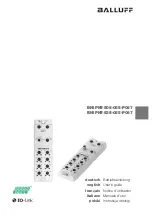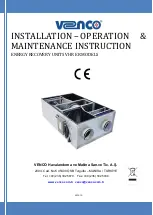
11
7.0 MAINTENANCE
7.1 Rear Access Cover Removal
The jack rear access cover must be removed to gain access to
various inspection, lubrication and maintenance points. Remove
the jack rear access cover as described in the following steps:
1. Unhook the rubber latches on each side of the cover. See
Figure 10.
2. Pull up on the cover until the round openings on the cover
keyways align with the cover support pins on the rear of the
hydraulic reservoir.
Figure 10, Rear Access Cover Removal
3. Gently guide the cover rearward until it has cleared the pins
and then lift the cover o
ff
of the jack.
4. Reverse steps 1, 2 and 3 to reinstall the cover. At the keyway
openings, be sure the groove in each cover support pin is
aligned with the cover sheet metal before fully installing the
cover onto the jack.
WARNING
Always reinstall the jack rear access cover
before using the jack. Except as necessary for maintenance
procedures, do not operate jack with cover removed. Serious
personal injury could occur if persons make contact with hot
surfaces or pressurized lines and components while cover is
removed. Damage could also occur if falling objects drop
onto exposed components.
7.2 Depressurizing the Jack Hydraulic and Pneumatic
Systems
For some maintenance procedures contained in Section 7 of
this manual, it is required that the jack hydraulic and pneumatic
systems be depressurized before the procedure can begin. These
operations are necessary to ensure the safety of the maintenance
personnel.
WARNING
Failure to follow the procedure in the following
steps may result in unexpected start-up of jack while
maintenance and repair procedures are being performed.
Uncontrolled release of pressure may also occur if
pressurized components are opened or pressurized fittings
are loosened. Serious personal injury could result.
NOTICE
The hydraulic system must be depressurized first,
before the pneumatic system is depressurized. Always be sure to
depressurize both systems.
1. Depressurize the jack hydraulic system, as described in
steps 1a through 1c:
a. Check that the jack is connected to the air supply and the
air-shuto
ff
valve is in the OPEN position.
b. Be sure the cylinder is in the fully retracted position.
c. Depress the pendant UP button while watching the
cylinder. Release the UP button IMMEDIATELY when the
cylinder starts advancing (usually after about 1 or 2 seconds).
This procedure will relieve any trapped pressure in the jack
hydraulic system.
NOTICE
To prevent hydraulic pressure from re-building in the
system, do not depress the pendant DOWN button at any time
during the following steps.
2. Depressurize the jack pneumatic system, as described in
steps 2a through 2f:
a. Move the jack air-shuto
ff
valve to the CLOSED position.
b. Disconnect air supply hose at jack air-shuto
ff
valve.
NOTICE
Jack may start and run briefly in the following step, as
trapped air is expelled from the jack pneumatic system.
c. Depress and hold the pendant UP button. Continue
holding button until jack air motor stops running. Motor will
usually stop after about 2 to 6 seconds, depending on length
of air supply hose.
d. Verify that there is no audible
“
air hiss
”
sound coming
from the jack.
e. Remove the jack rear access cover (if not already
removed). Refer to Section 7.1.
f. Check the air pressure gauge on the jack filter/lubricator.
Verify that it indicates zero (0) psi/bar.
NOTICE
If any pressure is indicated on gauge, be certain that
air-shuto
ff
valve is in the CLOSED position and that air hose is
disconnected from air shut-o
ff
valve. Then, repeat steps 2c
through 2f.
3. Proceed with desired maintenance or repair procedure.
7.3 Checking Oil Level
Check the hydraulic oil level every 90 days.
1. Be sure that cylinder is fully retracted and that the jack is
positioned on a firm and level surface.
2. Remove the jack rear access cover. Refer to Section 7.1.
3. Be sure the air shut-o
ff
valve is in the CLOSED position.
4. Unscrew and remove the oil fill plug. See Figure 11.
5. Check the oil level in the reservoir. Oil level should be
approximately 1 inch [25 mm] below top of reservoir, with
cylinder fully retracted and air motor turned o
ff
. See Figure 11.
6. If oil level is low, add Enerpac HF hydraulic oil as required.
Use a funnel to avoid spillage.
NOTICE
• Reservoir is vented. To prevent oil leakage through the air
breather, do not fill reservoir completely to the top.
• To help avoid accidental overfilling of reservoir, always make
sure that cylinder is fully retracted before checking oil level or
adding additional oil.
• If Enerpac HF is not available at the worksite, use an equivalent
hydraulic oil that meets the specifications shown in Table 8.
7. Reinstall oil fill plug.
8. Reinstall the jack rear access cover. Refer to Section 7.1.










































